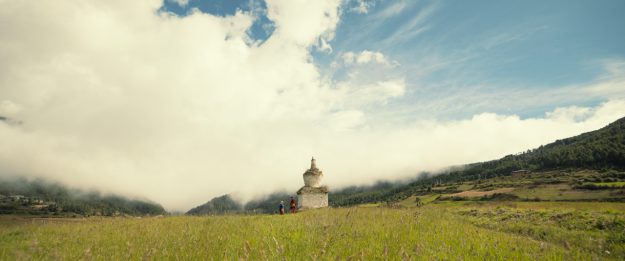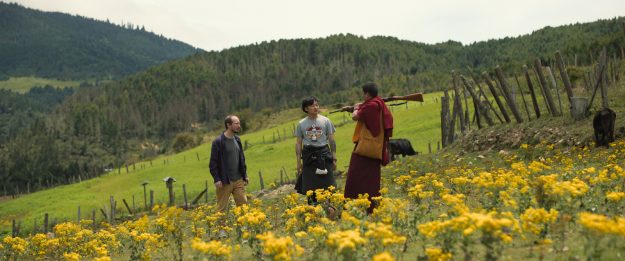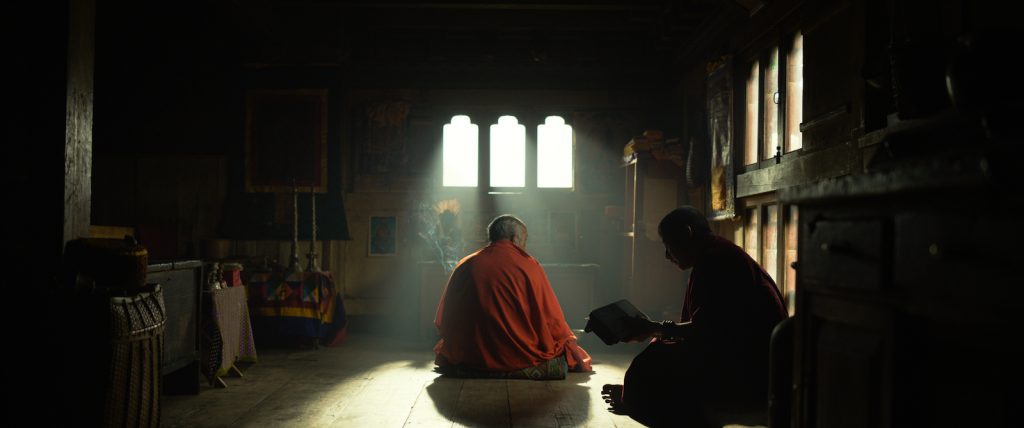Spoiler Alert: This piece discusses several plot details of The Monk and the Gun.
Bhutanese filmmaker Pawo Choyning Dorji, creator of Lunana: A Yak the Classroom (2019), has brought another gem from his Himalayan homeland to the big screen. I recently caught an early showing of his latest film, The Monk and the Gun (2023), at the Museum of Modern Art in New York City. In the film, shortlisted for Best International Feature for the 96th Oscars, Dorji takes us back to Bhutan’s first elections during its recent transition from monarchy to a democracy. He uses this pivotal moment to comment on the tension of a country trying to maintain its rich ancestral heritage despite embracing modernization and its subsequent consequences. Without being preachy, this wry allegory—filled with humor, irony, suspense, and redemption—positions Bhutan’s Buddhist essence and traditions in opposition to Western ideals and materialism.
The film takes place in 2006. Modernization has just arrived in the kingdom of Bhutan, with television and the internet, and the king has subsequently given orders for the country to become a democracy. To teach people how to vote, the authorities organize mock elections. The story, based on true events, takes place in the rural village of Ura in Bumthang, a valley where much of Bhutan’s early Buddhist history occurred. (For example, Bumthang is the valley where it is believed that Padmasambhava first arrived and performed miracles in the region. It is also the home and seat of the great Treasure Revealer Pema Lingpa.) Friction and discord erupt among the local villagers stirred up by early attempts at organizing the elections. The locals are less than excited about the push for a new form of government, having been quite satisfied living under their previous monarchs. In fact, the only reason that they are going along with the plan is that their beloved fourth king believes that this is best for the country, and they overwhelmingly trust his judgment. The competing parties and their differing philosophies for the mock elections vie for votes and loyalty—where voters are made to decide between the Red Party (i.e., industrial development), the Blue Party (i.e., freedom and equality), and the Yellow Party (i.e., preservation and tradition). This polarity ends up creating more problems than solutions, driving divisions at home, bullying at school, and distrust among neighbors. Suddenly, the kingdom known for its pursuit of Gross National Happiness is not looking so happy anymore.
Meanwhile, a monk named Tashi, played with understated perfection by Bhutanese singer/songwriter Tandin Wangchuk, walks beside an undulating field of grain and circumambulates a stupa, removed from the election furor. (Monastics in Bhutan are prohibited from voting or involvement in politics.) Tashi has been sent by his lama—the Tibetan translation of the Sanskrit guru (“teacher”)—in search of two guns. The lama needs the weapons for a ritual he will conduct to address the growing disharmony and, as he cryptically says, “put things right again,” on the upcoming full moon, which coincides with the mock election day.

Humorous scenes show officials sent from the capital to train the locals in party loyalty, encouraging them to engage in impassioned screaming and insults to the opposition. One grandma asks, “Why are you teaching us to be so rude? This is not who we are.” The political commotion alternates with scenes of another kind of education─folks congregating inside a convenience store watching the latest movie on the shop television. They watch an action-packed James Bond feature, eyes glued to an emblematic example of Western popular culture. The teenager at the counter chews gum and blows a bubble as the elders sit fervently spinning their prayer wheels. The monk joins the gathering and gets his first glimpse of the kind of gun the lama wants for his ritual. A flier on the wall advertises Quantum of Solace, giving new meaning to the 2008 film title.
Layered upon this is the arrival of an American tourist named Ronald Colman (a reference to actor Ronald Colman, who starred in the 1937 film Lost Horizon, an adventure fantasy about a group of people who crash in an idyllic Himalayan valley called Shangri-La). This Ron Colman, however, is a sleazy gun collector, who has come to Bumthang on a shopping expedition for a prized US Civil War rifle. He is willing to pay a hefty sum, but no one is interested in or swayed by his money. While Colman readily offers a hefty amount for the rifle, the Bhutanese owner of the gun agrees to sell it to him for a much lower price. Meanwhile, Tashi, making rounds through the village in search of two guns per his lama’s request, approaches the owner of the coveted gun. The elderly Bhutanese gentleman decides to donate the gun to the monk in support of the lama’s ritual. The gun sets the stage for the acts that follow, as authorities get wind of the potential gun deal and start to close in on the collector and his Bhutanese guide (arms and ammunition are highly regulated in the country).
The dangling threads come together on the mock election day, which draws the hoped-for crowd of locals─albeit mostly as a prelude to attending the lama’s full moon ritual. With drums beating, horns blowing, the chanting of prayers resounding, and the true-to-life physical activity of laying a foundation for a new stupa in the works, the ritual provides a reminder for everyone to overcome their propensity for anger and aggression and to be once again grounded in their heritage.
Dorji pokes fun at Western affects, the Bhutanese, and everyone else in between. In a final stroke of lighthearted irony, the results of the mock election are announced, and the Yellow Party is the overwhelming winner. Why? The king’s color has always been yellow (see: the flag of Bhutan), and everybody loves the king!

Having grown up all over the world as the child of a diplomat and having attended college in Wisconsin, Dorji is sensitive to how people from various parts of the world relate to the many distinct aspects of the plot. For instance, the film speaks to me personally as a poignant commentary on gun violence and the fragility of democracy because of current issues in the US. For Dorji (and the lama in the movie), the gun is a symbol of aggression and hatred. Rather than a political statement, the elections represent the push toward modernization. Nonetheless, the film offers a powerful message and raises thoughtful questions. Luckily, the story takes place in rural Bhutan, where religion is more popular than politics. So the movie can deliver a happily-ever-after ending that underscores the people’s enduring principles inspired by Buddhist values.
Dorji is a remarkable storyteller and director who writes the scripts for all of his movies, often revising them up to the last minute to accommodate his casts of mostly nonactors. He also has a mischievous knack for unlikely pairings, such as a yak in a classroom, and the Buddhist monk with a gun of the title. These juxtapositions open the door to the idea that things do not always follow a logic with which we are familiar. But in another culture, in another context, they may make perfect sense.
In his introductory remarks at the MoMA screening, Pawo Choyning Dorji explained that there is no word for “storytelling” in many Bhutanese dialects, even though there is a rich storytelling tradition in the culture. The activity is often referred to as “untying a knot.” Let’s hope there are more knots up Dorji’s sleeve.
The Monk and the Gun is currently in select theaters.
Thank you for subscribing to Tricycle! As a nonprofit, we depend on readers like you to keep Buddhist teachings and practices widely available.
